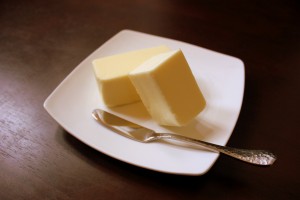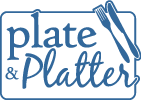-
Clarified: Butter is Better
Posted on February 21, 2013 by Becka in Food Musings, Recipes. There are a lot of products on the market nowadays that are intended to be butter substitutes. But in my opinion, there’s no substitute for great butter. People are concerned with the amount of saturated fat in butter, but as long as you practice moderation, you shouldn’t need to exclude anything from your diet. There are certain times when butter is just better. For example, eggs. I always scramble or fry my eggs in a little pat of melted butter. The rich flavor it adds is unparalleled when it comes to cooking fats. Or take baked goods. Imagine a croissant without butter; impossible. And we can’t forget bread and butter. I’ll go out on a limb here and say I might not even be interested in bread if it weren’t for butter.
There are a lot of products on the market nowadays that are intended to be butter substitutes. But in my opinion, there’s no substitute for great butter. People are concerned with the amount of saturated fat in butter, but as long as you practice moderation, you shouldn’t need to exclude anything from your diet. There are certain times when butter is just better. For example, eggs. I always scramble or fry my eggs in a little pat of melted butter. The rich flavor it adds is unparalleled when it comes to cooking fats. Or take baked goods. Imagine a croissant without butter; impossible. And we can’t forget bread and butter. I’ll go out on a limb here and say I might not even be interested in bread if it weren’t for butter.Butter in its whole form isn’t the only way to take advantage of this age-old ingredient though. Clarifying butter opens your world to many other possibilities.
What is clarified butter? It’s the butter fat that’s left over after removing the milk solids and water that are present in butter. Whole butter is about 80-88% butter fat, depending on the type you purchase. Your standard store brand is going to be closer to the 80% mark and a really creamy French butter will stand on the other end of the spectrum. When you remove the milk solids and water that make up the rest of butter’s contents, you’re left simply with the butter fat which has many useful applications.
 Among them: popcorn. If you’ve ever popped your own kernels at home and drizzled them with melted butter, you’ve probably been disappointed because the popcorn gets soggy. Well, if you use clarified butter, you’ll get that great buttery flavor and the kernels stay nice and crisp. Clarified butter is also great for sautéing. By removing the milk solids which can burn at lower temperatures, you’ve created a cooking fat that can withstand heat up to 485 degrees. This makes for excellent sautéed mushrooms. Because they absorb so much flavor and liquid, mushrooms sautéed in clarified butter are the best kind.
Among them: popcorn. If you’ve ever popped your own kernels at home and drizzled them with melted butter, you’ve probably been disappointed because the popcorn gets soggy. Well, if you use clarified butter, you’ll get that great buttery flavor and the kernels stay nice and crisp. Clarified butter is also great for sautéing. By removing the milk solids which can burn at lower temperatures, you’ve created a cooking fat that can withstand heat up to 485 degrees. This makes for excellent sautéed mushrooms. Because they absorb so much flavor and liquid, mushrooms sautéed in clarified butter are the best kind.I’m not advocating you go to town and eat the whole stick at once, but a little butter from time to time in the appropriate applications can’t be beat. Sometimes, there really is no substitute.
Clarified Butter
Melt butter in a saucepan over low heat. Once melted, skim the white milk solids that have risen to the top. Pour the middle layer of clarified butter into a container, taking care not to pour out the water and any other milk solids that have gathered at the bottom of the pan. Refrigerate and scoop out as needed.


